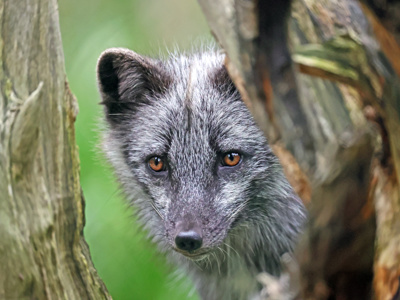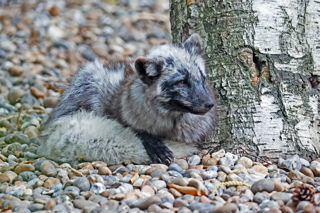
Arctic Fox
Vulpes lagopus
Arctic foxes are highly adapted to living in extreme winter conditions. They are similar in size to a red fox, and can weigh between 3-8kg. They have a striking thick, fluffy coat which enables them to maintain a consistent body temperature, provide insulation and can be used as camouflage.
The coat of the arctic fox changes colour with the season. In the summer, their coats are brown or black. They then turn white in winter, allowing it to camouflage with the snow and ice.

Habitat
Arctic tundra, which are stark and open landscapes with few plants and mainly heathland. Can also be found in Arctic coastal areas free of ice.

Behaviour
Arctic foxes are active all year round, but less so before winter. They do not hibernate, but will slow down to preserve fat and calories.
They stay warm with their thick, fluffy coat, long bushy tails, and thickly haired paw pads which insulate against the cold and provide traction on ice.
Using their acute hearing and keen smell, they can locate prey under the ice and pounce into the snow to catch them hidden beneath.

Threats
Climate change has historically affected the range and distribution of Arctic foxes. Hunting for fur has also been a long term threat; in recent years the fur hunting industry has declined, which means pressures have also subsided.
Competition and other associated problems (such as disease transmission, predation of kits, and interbreeding) with the presence of other species such as the red fox and domestic dogs is having a dramatic effect on some populations.
Distribution
Found throughout the Arctic in tundra habitats within North America, Asia and Northern Europe.
Diet
A wide range of food makes up the arctic fox diet. Their main prey is lemmings, but they will hunt smaller animals and scavenge for food left over from polar bears, including fish and seals. They will eat invertebrates, eggs, berries, and even seaweed.
Status
Arctic foxes were present in the UK at the time of the last Ice Age. As the climate warmed, and the ice receded, so did the range of the Arctic fox
Wildwood inside information
We have two adult Arctic foxes; Albert and Flo. You can regularly see our foxes sleeping in their enclosure. Be sure to visit in both winter and summer to compare their coat transformations.
Family facts
The beautiful coat of the Arctic fox is the warmest of any animal in the Arctic. They can withstand temperatures down to -70°C.

